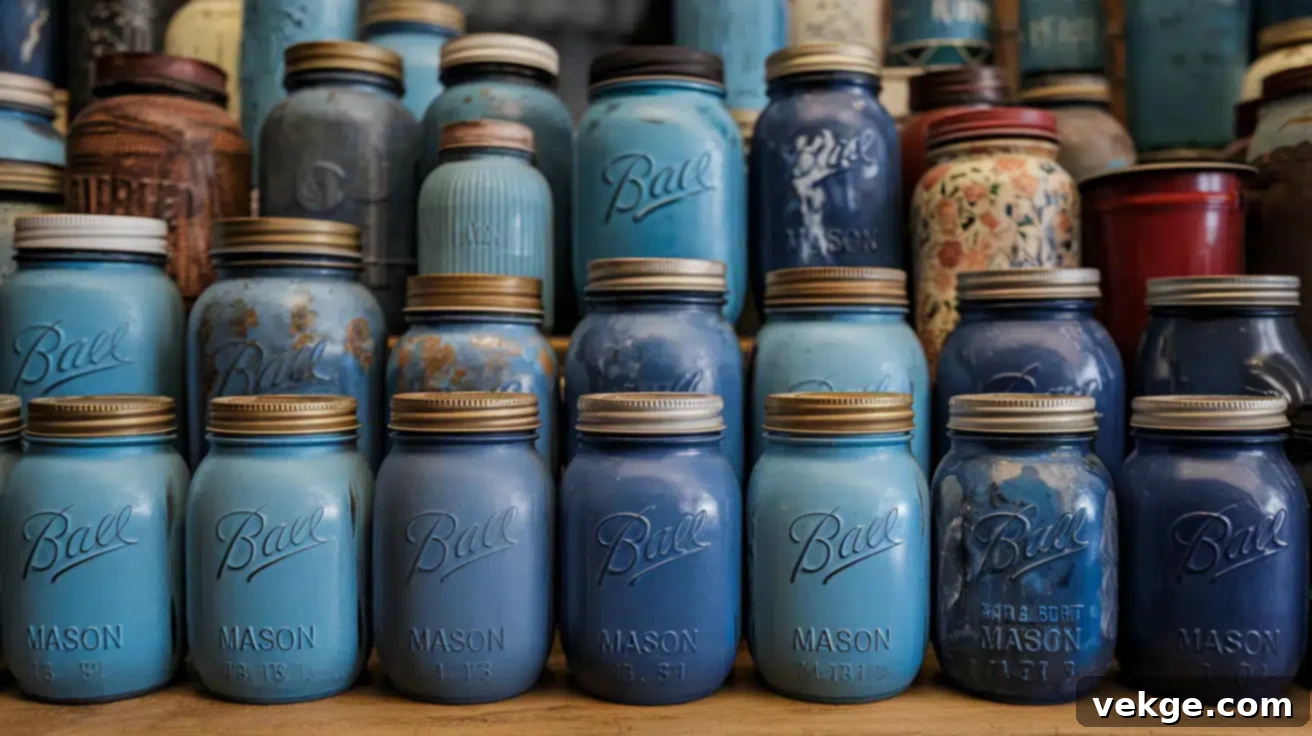Discover the Value of Blue Mason Jars: Your Ultimate Guide to Identifying and Collecting Antique Treasures
Since their patenting by John Landis Mason in 1858, Mason jars have profoundly transformed home food preservation, cementing their place as cherished symbols of American ingenuity and cultural heritage. From humble kitchen staples to sought-after collectibles, these iconic glass vessels tell a story of innovation and enduring design.
Among the vast spectrum of vintage canning jars, blue Mason jars hold a particularly special place in collectors’ hearts. Their distinctive azure, aqua, or deep cobalt hues, combined with their significant historical background, make them stand out. These radiant glass treasures frequently command premium prices on antique shelves and spark engaging conversations about America’s rich glass-making tradition.
Far beyond their original utilitarian purpose, these jars represent a bygone era of meticulous craftsmanship, when everyday items were built to last for generations. This comprehensive guide delves into the captivating history, precise identification techniques, and lasting appeal of blue Mason jars—objects that seamlessly blend practical design with timeless charm, offering both a glimpse into the past and a valuable investment for the discerning collector.
What Makes Blue Mason Jars Valuable?
Historical Context and Rarity of Blue Mason Jars
The allure and value of blue Mason jars are intrinsically linked to their fascinating historical context and inherent rarity. Most authentic blue Mason jars date back to the late 19th century and the early decades of the 20th century, primarily between 1880 and 1920. During this period, glass manufacturers, most notably the Ball Corporation, often added manganese dioxide to their glass formula. This seemingly ordinary additive had an extraordinary effect: when exposed to ultraviolet (UV) light—primarily sunlight—over many years, it slowly reacted, causing the glass to develop its characteristic blue-aqua coloration.
The blue color was, for the most part, an unintended by-product. It stemmed from natural mineral impurities, particularly iron, present in the sand used for glass production. The manganese dioxide was initially added as a decolorizer to make glass appear clearer by neutralizing the green tint caused by these iron impurities. However, long-term sun exposure revealed the unique blue hue we cherish today.
The Ball Corporation’s “Ball Perfect Mason” series, produced between approximately 1880 and 1920, remains the most famous and highly coveted among blue Mason jars. These early blue jars are significantly rarer than their clear counterparts for several reasons:
- Manufacturing Shift: Glassmakers eventually discovered alternative ingredients and refined processes that allowed them to produce truly clear glass without the need for manganese or other mineral additives that would react to sunlight. This transition effectively ended the era of naturally blue-tinted jars.
- Usage and Survival: Many blue jars were heavily used for their original purpose of food preservation. This meant they were subjected to repeated sealing, heating, and handling, leading to breakages, chips, and cracks. Consequently, fewer examples survived in pristine or even good condition over the decades, further enhancing the value of those that did.
This confluence of a specific historical manufacturing technique, an accidental but beautiful chemical reaction, and the test of time has elevated blue Mason jars from simple canning vessels to treasured pieces of Americana.
Factors that Impact the Value of Blue Mason Jars
While the overall charm of a blue Mason jar is undeniable, several specific factors significantly influence its market value. Understanding these elements is crucial for both new and seasoned collectors looking to make informed decisions.
- Age and Rarity: Generally, the oldest examples fetch the highest prices. Blue Ball jars produced between 1910 and 1923, particularly those embossed with “Ball Perfect Mason,” are especially prized due to their age and historical significance. Jars from lesser-known regional manufacturers, or those with unusual production dates, can also be highly valuable due to their scarcity.
- Condition: The physical state of a jar is paramount. Jars free from chips, cracks, significant scratches, or cloudiness (hazing from mineral deposits or dishwasher use) are far more valuable. Even a minor chip can drastically reduce its worth. The presence of the original closure mechanism—whether a zinc lid, a glass lid with a wire bail, or a two-piece lid—especially if it matches the jar’s age and style, can significantly increase its value. Original rubber seals, though rare to find intact, are a bonus.
- Unique Features and Imperfections: What might seem like a flaw in modern manufacturing often indicates authenticity and adds value to antique jars.
- Pontil Marks: These rough circular scars on the jar bottom indicate early, hand-blown production methods. Different types exist, such as bare pontil marks (simple rough circle), iron pontil marks (often with a rusty tint), or glass-tipped pontil marks (a small glass shard attached).
- Unusual Embossing: Jars with rare or unique embossing patterns, misspellings, or specific patent dates (like “MASON’S PATENT NOV 30TH 1858” on non-Ball jars) are highly collectible. The clarity and sharpness of the embossing also play a role.
- Uncommon Blue Shades: While aqua blue jars are relatively common, deeply saturated cobalt blue examples are exceedingly rare and command premium prices. The intensity and evenness of the blue color can greatly impact value.
- Sizes and Shapes: Half-gallon, gallon, or other unusual sizes (like very small pint or half-pint jars) are rarer than standard quart sizes and often command higher prices. Jars with square shoulders are typically older and more sought-after than those with rounded shoulders.
- Bubbles and Asymmetry: Tiny air bubbles trapped within the glass are a hallmark of early hand-blown or semi-automated production. Slight asymmetry in the jar’s mouth or body also indicates early manufacturing techniques and authenticity.
- Manufacturer Markings and Logo Style: The style of the “Ball” script, or other manufacturer’s logos, helps to accurately date and value each piece. Older jars typically feature more elaborate, cursive lettering with distinct loops and flourishes. Collectors specifically seek jars with logo styles from limited production periods, as these offer precise dating. Examining the base for mold numbers (single digits, letters, or symbols) can also provide clues about its production run.
Types of Blue Mason Jars and Their Value
Blue Mason jars come in a spectrum of hues and production eras, each with its own characteristics and value proposition. Understanding these categories is essential for serious collectors.
Antique Blue Mason Jars (Pre-1920s)
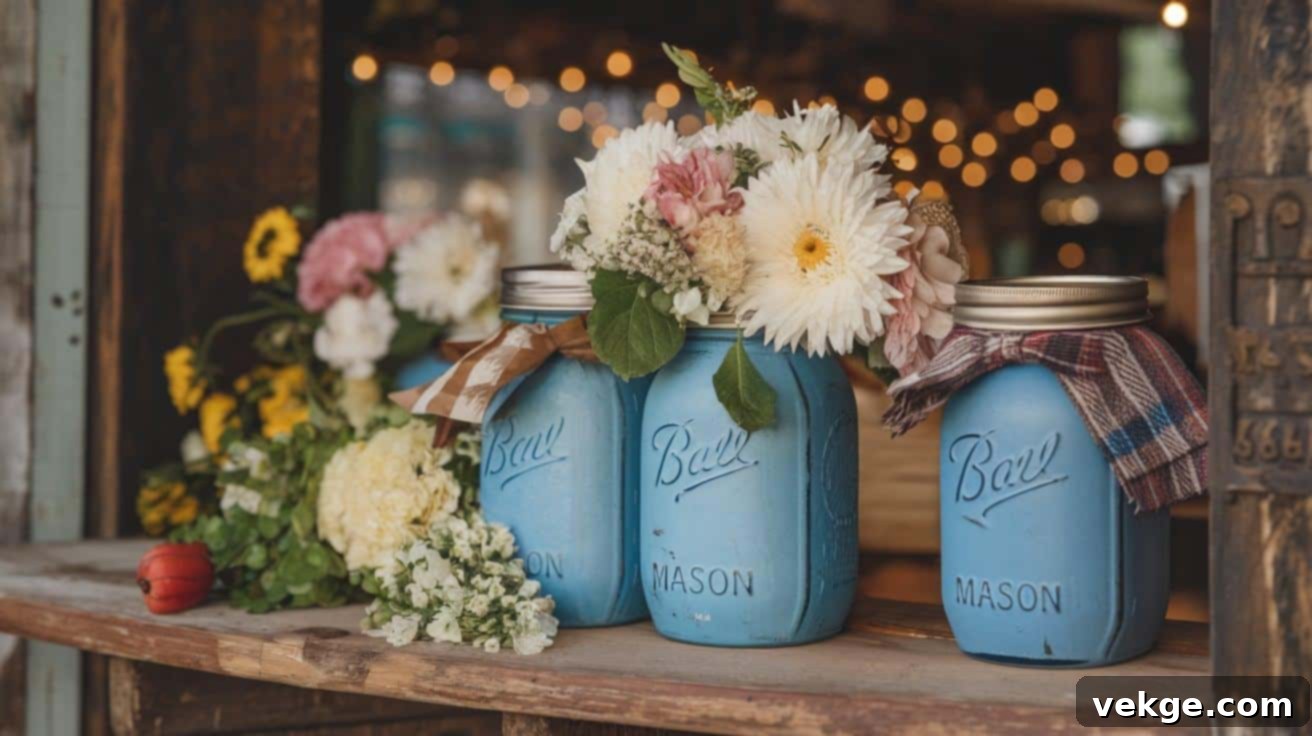
These are the crown jewels for many collectors. Dating from the late 19th century up to the early 1920s, these jars exhibit distinct hand-blown characteristics. Look for charming imperfections such as asymmetry in the body or mouth, visible pontil marks on the base (indicating where the glassblower’s punty rod was attached), and tiny air bubbles trapped within the glass. The glass itself often feels thicker and heavier.
- Value: These command the highest prices, ranging from tens to hundreds, or even thousands, of dollars for exceptionally rare examples.
- Key Brands: Ball’s “Perfect Mason” series from this era is highly prized. Atlas “Strong Shoulder Mason” jars are also sought-after runners-up. Kerr blue jars, while less common in deep blue, have a loyal following. Lesser-known regional brands like Drey and Knox can fetch premium prices due to their scarcity, especially if they feature unusual closure types or unique embossing variations.
Aqua Blue Mason Jars
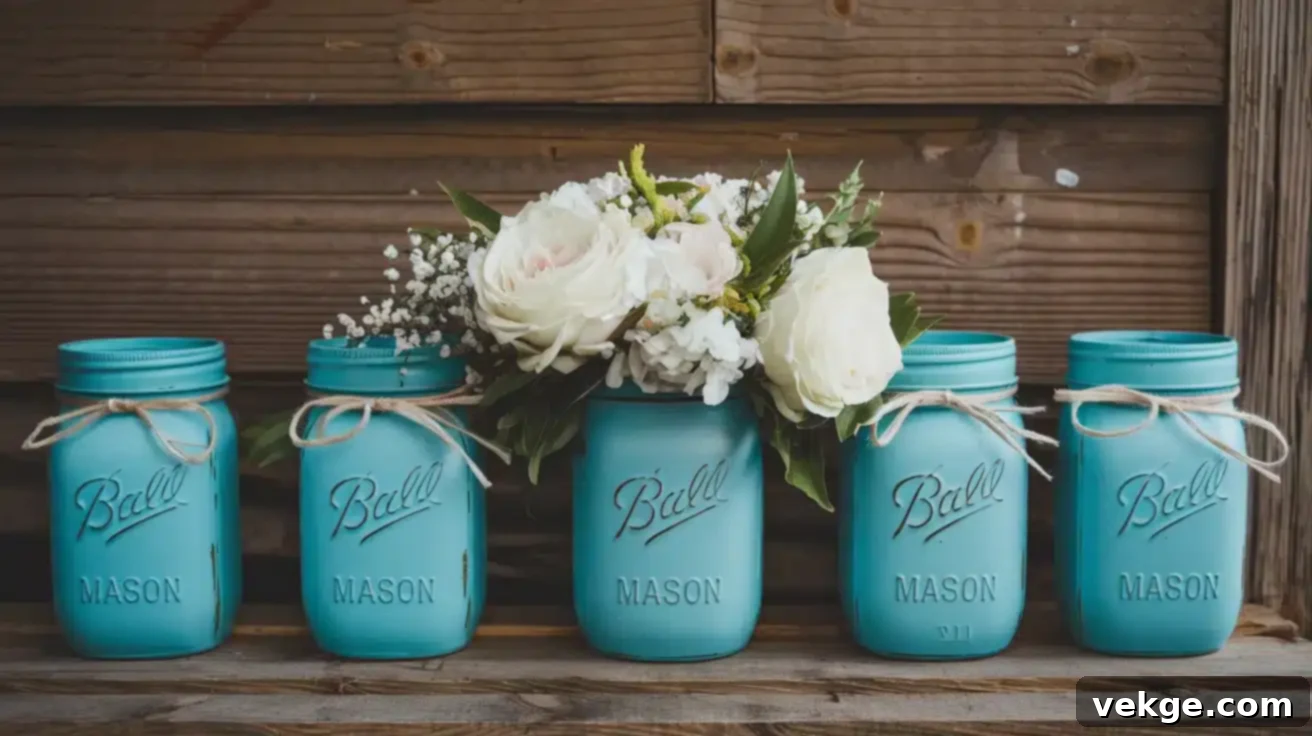
Displaying a lighter, often greenish-blue tint, aqua blue jars are the most common of the naturally colored blue varieties. This coloration typically resulted from iron impurities in the sand used in glass production, combined with the decolorizing effects of manganese. Most date from the 1880s to the early 1900s, though some later examples exist.
- Value: These jars are generally more affordable, ranging from a few dollars to $30-50 for well-preserved examples. Their subtle coloration makes them excellent entry points for new collectors or those seeking decorative pieces.
- Characteristics: The hue can range from barely perceptible blue to a distinct aquamarine. They often still feature early production characteristics like bubbles, but pontil marks are less common than in true antique blue jars.
Cobalt Blue Mason Jars
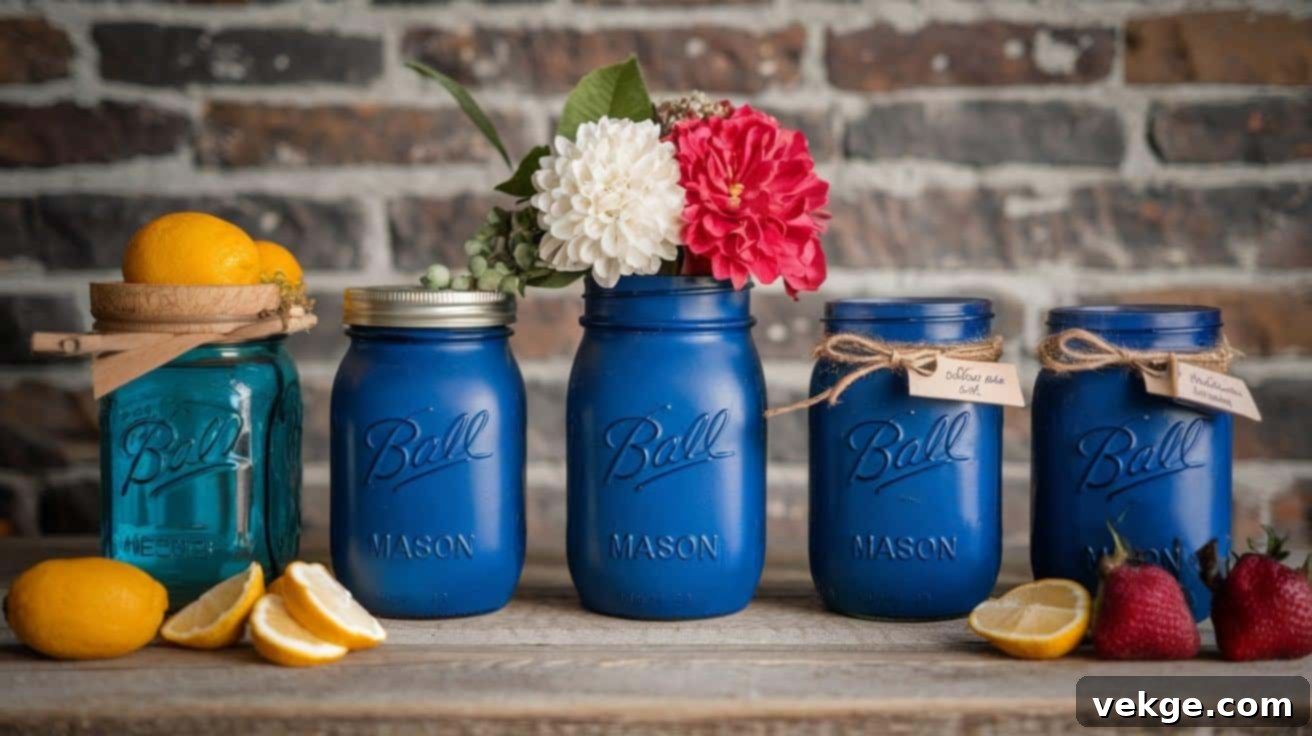
Exhibiting a deeper, more intense, and vibrant blue color, true cobalt blue Mason jars are considerably rarer and more valuable than aqua varieties. This profound blue was achieved by deliberately adding cobalt oxide to the glass mixture, rather than relying on natural mineral reactions.
- Value: True cobalt examples came from very limited Ball Corporation production runs and represent the “crown jewels” of Mason jar collecting. These command significantly higher prices—sometimes hundreds or even thousands of dollars—especially for rare sizes or pristine condition. The deeper and more uniform the blue, the higher the value.
- Identification: Be wary of modern reproductions that mimic this deep blue. Authentic cobalt jars will often have the same manufacturing characteristics as other antique jars, such as slight asymmetry and bubbles, but with the distinct, intense color.
Vintage Blue Mason Jars (1900s-1960s)
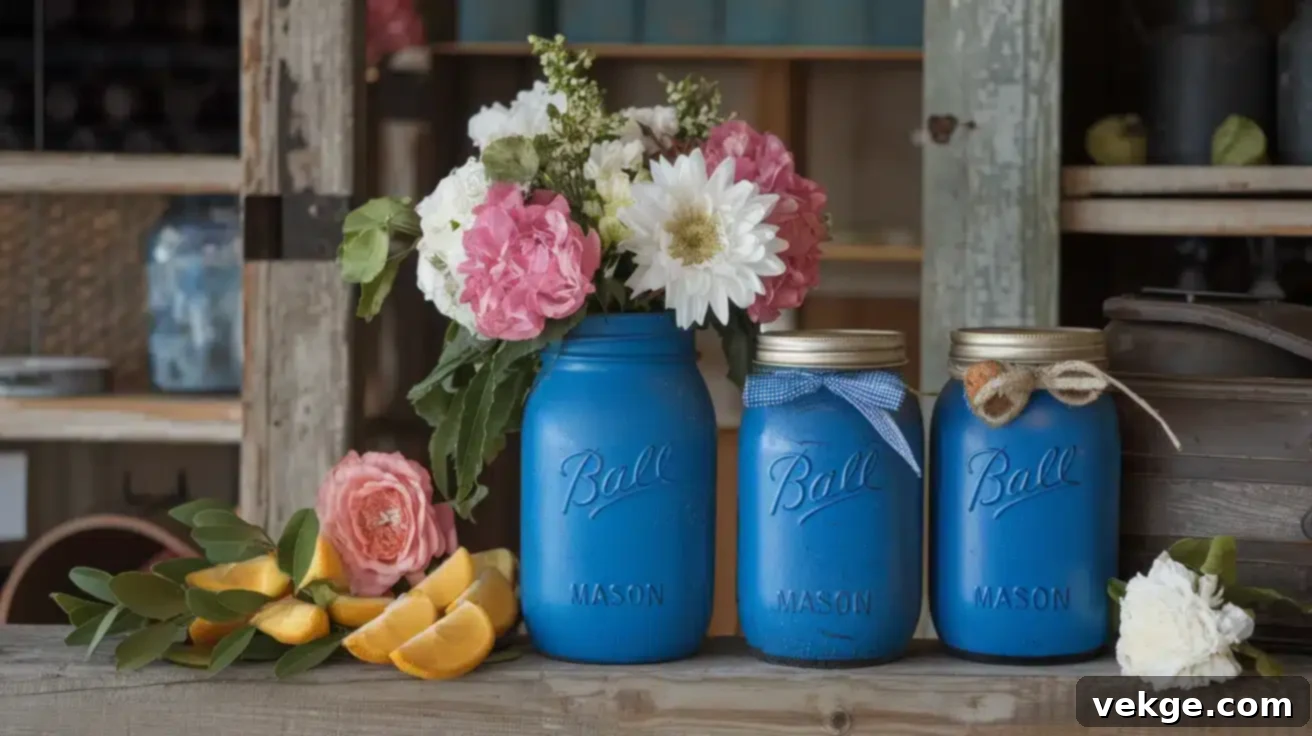
This category encompasses jars produced with thicker glass walls and often displaying naturally occurring blue hues, though less pronounced than the antique or cobalt varieties. These jars were created with semi-automated machines, which means they will show more distinctive mold seams and greater uniformity than truly hand-blown pieces. While post-1923 Ball jars are technically “clear,” many older “clear” jars from this era still exhibit a very faint aqua or bluish tint due to the lingering use of manganese in the glass formula and subsequent sun exposure.
- Value: They hold significant collector value based on condition, rarity of specific embossings, and manufacturer. Most serious collectors focus on this accessible category to build their collections. Price points remain manageable for casual collectors while still offering investment potential for rare examples.
- Characteristics: Look for clearly defined mold seams, various “Ball” logos (script, block letters), and patent dates from the early to mid-20th century.
Modern Reproduction Blue Mason Jars
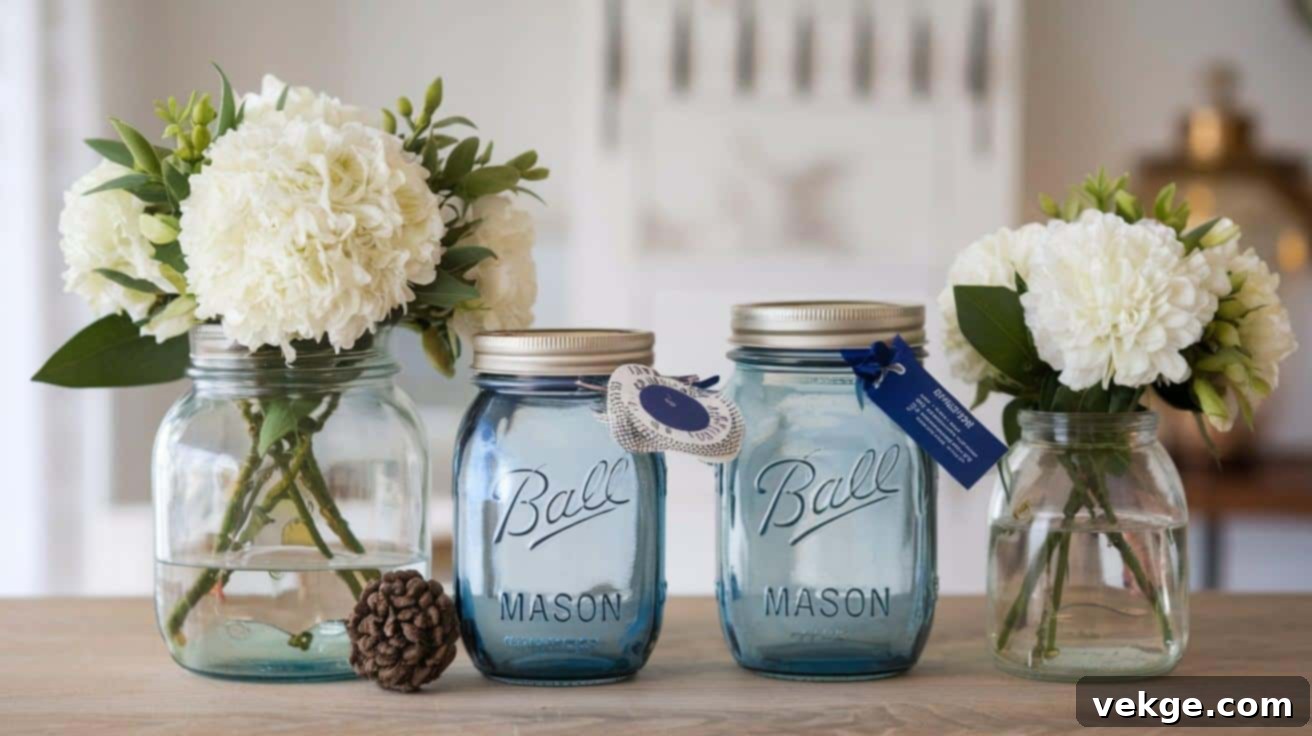
Today, companies like Ball and others produce blue-colored Mason jars purely for decoration or modern use. These jars utilize artificially colored glass and fully automated production processes. The result is perfectly uniform shapes, consistent colors, and a distinct lack of the unique character found in antique examples.
- Value: Modern reproductions are rarely appreciated beyond their retail price. They hold no collector’s value in the antique market and are generally avoided by serious collectors who prefer authentic, naturally aged pieces.
- Use: While not valuable as collectibles, they are highly useful and popular for crafts, home decor, modern canning, and event decorations.
- Identification: These jars will look “too perfect,” with no bubbles, pontil marks, or asymmetry. The blue color will be unnaturally uniform and often a bright, primary blue.
How to Identify a Valuable Blue Mason Jar
Distinguishing a rare and valuable blue Mason jar from a common or modern reproduction requires a keen eye and knowledge of specific identifying features. Here’s what to look for:
Markings and Embossing
The text and symbols pressed into the glass are often the most telling indicators of a jar’s age and origin:
- Ball Logo Variations: Pay close attention to the “Ball” logo. Earlier jars (pre-1923) feature a more elaborate, cursive script with distinct loops and flourishes (often called “script Ball”). Later jars transitioned to block letters. Specific variations, like whether there’s a period after “Ball,” can pinpoint production years.
- Patent Dates: Look for patent dates such as “MASON’S PATENT NOV 30TH 1858.” While this date refers to John Landis Mason’s original patent, jars bearing it were produced decades later. The presence of this specific patent date on non-Ball jars can indicate a rare regional manufacturer.
- Mold Numbers and Letters: Numbers (typically single or double digits) or letters on the jar bottom or sometimes near the base indicate the specific mold used in production. Lower numbers or unusual letter codes can sometimes suggest earlier production runs or specific factories, which can increase value.
- City Names: Some rare blue Mason jars, particularly those from regional glassworks, may display city names like “Buffalo” or “Philadelphia.” Such unique geographic indicators significantly increase their collector value due to scarcity.
- Misspellings or Unique Phrases: Any unusual embossing, misspellings, or unique phrases can indicate a rare variant or a limited production run, making the jar highly sought after.
Jar Shape and Features
The physical characteristics of the jar itself offer valuable clues:
- Shoulder Shape: The most valuable blue Mason jars often have distinct “square shoulders” where the jar body transitions to the neck, rather than smoothly rounded ones. This square-shoulder design is characteristic of earlier production.
- Bubbles in the Glass: Tiny air pockets or seed bubbles trapped within the glass are a strong indicator of hand-blown or early machine production. Modern jars are typically flawless.
- Pontil Marks: As mentioned, these rough circular scars on the jar bottom are definitive signs of early hand-blown production. Run your finger across the bottom; if it feels rough or has a distinct ring, it’s likely a pontil mark.
- Rare Sizes: While quart jars are common, half-gallon, gallon, or very small (e.g., jelly jar) blue Mason jars are rarer and typically command premium prices due to their limited production.
- Unusual Lid Mechanisms: Jars with rare or unique lid mechanisms or closure types, such as “Lightning” wire bails, glass lids with rubber seals, or specific types of zinc lids, can significantly increase a jar’s value, sometimes doubling or tripling it.
Imperfections as Value Indicators
Paradoxically, what might be considered flaws in modern glass often serves as authentication for antique blue Mason jars, signaling their age and the craftsmanship of a bygone era:
- Glass Waves or Ripples: Visible waves or subtle ripples in the glass indicate hand-finished production methods or the less refined processes of early glass machines. This unevenness is a hallmark of authenticity.
- Stretching Marks: Fine, horizontal lines or “stretch marks” near the base or neck of the jar can show where the glass was manually pulled or shaped during its finishing process.
- Asymmetry: A slight lack of perfect symmetry in the jar’s mouth, body, or base strongly suggests early manufacturing techniques where precision was not as advanced as today’s automated systems.
- Color Swirls or Uneven Tinting: In naturally blue jars, slight variations in the blue tint or subtle color swirls point to natural mineral variations in the sand during production. The blue may be lighter in some areas and darker in others, which is a sign of authenticity, especially when compared to uniformly colored modern reproductions.
These “flaws” are not defects but rather fingerprints of history, authenticating the jar’s age and craftsmanship, and distinguishing valuable antiques from perfectly uniform modern reproductions.
Common Mistakes to Avoid When Identifying Blue Mason Jars
Collecting blue Mason jars can be a rewarding hobby, but it’s crucial to navigate the market with caution to avoid common pitfalls. Misidentification can lead to overpaying for reproductions or missing out on true treasures.
Reproduction Warning Signs
Modern reproductions are widely available and can sometimes be deceptively convincing. Watch out for these red flags:
- Perfect, Uniform Blue Coloring: Genuine antique blue jars often have variations in color intensity, subtle swirls, or lighter/darker patches due to natural mineral content and uneven sun exposure. Reproductions typically have a perfectly consistent, often bright, blue hue throughout the entire jar.
- Overly Crisp, Machine-Precise Embossing: While antique embossing can be sharp, it often shows subtle signs of wear, slight irregularities, or less perfect edges due to older molds and production processes. Reproductions will have embossing that feels too sharp, clean, and perfectly uniform, lacking any character.
- Flawless Threads: The threads around the jar mouth on antique jars might show slight irregularities, minor unevenness, or even some hand-finishing marks. Reproduction threads are often perfectly smooth, uniform, and machine-cut.
- Perfectly Centered Logos without Production Variations: Antique jars, especially from early production runs, can have logos that are slightly off-center, tilted, or have minor variations due to less precise machinery. Reproductions will almost always have perfectly centered and aligned logos.
- Deliberately “Aged” Appearance with Artificial Whitening: Some reproductions attempt to mimic age by applying artificial hazing or whitening to the glass. This often looks superficial and unnatural compared to genuine patina developed over decades.
- Lack of Subtle Glass Imperfections: As discussed, true antiques will almost always have small air bubbles, waves, or slight asymmetries. Reproductions are typically free of these “flaws,” appearing too perfect and sterile.
Investment Pitfalls
Beyond identifying reproductions, collectors should be aware of common investment mistakes:
- Paying Premium Prices for Common Post-1923 “Ball Perfect Mason” Jars: While “Ball Perfect Mason” jars are popular, those produced after 1923, especially the truly clear ones, are far more common and hold significantly less value than their earlier, naturally blue counterparts.
- Believing All Blue Jars Are Rare: It’s a common misconception that any blue jar is inherently rare. Aqua blue jars, particularly lighter shades, are relatively common and should not command the same prices as rarer cobalt or deep antique blue specimens.
- Confusing Artificially Colored Jars with Naturally Blue Antiques: Some jars may have a surface coating or dye to make them appear blue. Always verify that the blue color is integral to the glass itself, not just a surface treatment.
- Not Researching Current Market Values: Before purchasing, always research what similar jars are selling for on reputable platforms. Prices can fluctuate, and knowing the current market average helps prevent overpaying.
- Mistaking UV-Exposed Purple Jars for Naturally Colored Ones: While some glass with manganese can turn purple with extensive UV exposure (often done artificially to create “sun purple” jars), this is a different phenomenon than the natural blue tint and typically doesn’t hold the same antique value unless it’s a naturally occurring, rare purple-amethyst shade.
- Buying Based on Photos Alone: Whenever possible, examine jars in person. Photos can hide chips, cracks, cloudiness, or misrepresent true color. If buying online, request multiple high-resolution photos from various angles, especially of the base and embossing.
Best Places to Search for Blue Mason Jars
The thrill of the hunt is a significant part of collecting blue Mason jars. Knowing where to look can greatly increase your chances of finding valuable pieces at reasonable prices.
Estate Sales
Estate sales are often treasure troves for genuine antique and vintage items, including blue Mason jars. These sales frequently include household collections from older homes, where jars may have been stored for decades, often forgotten in basements or pantries. Arrive early on the first day of the sale for the best selection, and don’t hesitate to politely inquire if there are any canning jars not yet displayed. Focusing on rural areas or regions with historical glass manufacturing (such as Ohio, Indiana, and Pennsylvania) can significantly increase your odds of valuable finds.
Flea Markets and Farm Auctions
Country flea markets and rural farm auctions are excellent venues for discovering blue Mason jars. Sellers at these less formalized venues may not always recognize the true value of their items, potentially offering bargains. Regional farm auctions can be particularly rewarding, as they often feature items cleared from barns, cellars, or outbuildings where jars might have been stored for generations. The relaxed atmosphere often means more competitive pricing than specialized antique shows.
Antique Shops and Shows
Specialized antique shops and antique malls maintain curated selections of blue Mason jars. While prices here tend to be higher due to dealer expertise and overhead, the authenticity and quality are generally more reliable. Antique shows bring together numerous knowledgeable dealers with a wide inventory, offering a great opportunity to see many different types of jars in one place. Building relationships with reputable dealers can even lead to first access to rare jars before they reach public display, as dealers often acquire new stock regularly.
Online Marketplaces
The digital age has opened up vast opportunities for collectors:
- eBay: Remains the largest online marketplace. Use specific search terms like “antique blue Mason jar,” “vintage Ball jar aqua,” or “cobalt Mason jar.” Filter results by “vintage” or “antique” to narrow down the offerings. Always review seller ratings and ask for detailed photos.
- Etsy: A popular platform for vintage and handmade goods. Many sellers specialize in curated antique collections, often providing good descriptions and photos.
- Facebook Marketplace and Local Pickup Options: These platforms can yield excellent local deals, avoiding shipping costs (which can be high for fragile glass). Always arrange to meet in a safe, public place.
- Specialized Auction Sites: Websites like Barnebys, LiveAuctioneers, or Ruby Lane feature authenticated antiques from professional dealers, though items here often come with premium prices and buyer’s fees. These are ideal for seeking very rare or high-value pieces.
Thrift Stores and Yard Sales
For patient treasure hunters, overlooked blue Mason jars can occasionally be found at surprisingly low prices in thrift stores like Goodwill, Salvation Army, or independent charity shops. Regular visits are key, as inventory constantly changes. Similarly, community yard sales and garage sales, particularly in older neighborhoods, can occasionally reveal valuable jars at bargain prices. Early morning shopping often yields the best results at these venues, as the most desirable items tend to sell quickly.
How to Spot a Good Deal Regarding Blue Mason Jars
Finding a good deal on a blue Mason jar involves a combination of careful authentication, accurate value assessment, and an awareness of red flags. It’s about more than just a low price; it’s about recognizing true value.
Authentication Tips
Before considering the price, verify the jar’s authenticity:
- Examine the Base: Look for pontil marks (rough scars) or mold numbers/letters. The presence of a pontil mark is a strong indicator of early production.
- Check for Authentic Wear Patterns: Antique jars will likely show subtle signs of age and use, such as minor scratches or slight wear around the threads where lids were applied and removed repeatedly.
- Verify the Blue Color: Ensure the blue hue is integral to the glass, not a surface coating, dye, or artificial tint. Look through the mouth of the jar to see the true color of the glass edge.
- Look for Natural Imperfections: Search for small air bubbles, waves, ripples, or slight asymmetry in the glass. These are hallmarks of genuine antique production.
- Research the Embossing Pattern: Compare the manufacturer logo and any patent dates or unique phrases to known authentic examples and their production periods.
- Verify the Weight: Antique jars often feel heavier and more substantial than modern reproductions due to thicker glass.
Value Assessment
Once authenticated, assess its market value:
- Compare Current Prices: Use online marketplaces, auction results, and collector guides to compare current selling prices for jars of similar type, condition, and rarity.
- Factor in Condition: Be realistic. Even minor chips or cracks can significantly reduce a jar’s value, sometimes by 50% or more. Cloudiness (hazing) is also a major detractor.
- Consider Completeness: A jar with its original, matching lid and seal (especially a glass lid with a wire bail) will be significantly more valuable than a jar alone.
- Verify Age Through Marks: Accurately dating the jar using its embossing style, mold marks, and production features is key to understanding its rarity and value.
- Understand Color Rarity: Remember that true cobalt blue is far rarer and more valuable than aqua blue. Distinguish between these carefully.
- Account for Shipping Costs: When buying online, factor in the cost of professional packing and shipping for fragile glass. This can add a significant amount to the overall price.
Red Flags
Be cautious if you encounter any of these warning signs:
- Sellers Unable to Provide Close-Up Photos: A reputable seller should be happy to provide detailed images of embossing, the base, and any imperfections.
- Jars with Too-Perfect Coloring or Artificially Induced Purple Tones: As discussed, perfect uniformity or a strong, artificial-looking purple tint (often from forced UV exposure) should raise suspicion.
- Claims of Extreme Rarity Without Supporting Documentation: Be skeptical of claims of “one-of-a-kind” or “unheard-of” rarity without historical evidence or expert verification.
- Reluctance to Show the Jar in Natural Lighting: Artificial lighting can mask flaws or alter the perceived color. Always request photos in natural daylight.
- Perfect Condition Claimed for Very Old Jars: While “mint condition” antique jars exist, they are exceptionally rare. A claim of perfect condition for a jar over 100 years old warrants careful scrutiny.
- Prices Significantly Below Market Value for Rare Varieties: If a rare cobalt blue jar is offered at a price that seems too good to be true, it likely is a reproduction or has significant damage.
Conclusion
Beyond their captivating appearance, blue Mason jars represent a unique and rich chapter in American manufacturing and social history. These beautiful vessels connect us directly to an era when household items were crafted with care, intended for longevity, and played a vital role in family sustenance. Collecting them offers more than just ownership; it’s an engagement with the past, a celebration of design, and a testament to enduring utility.
For newcomers embarking on the journey of jar collecting, patience and continuous education are paramount. Dedicate time to visiting local antique shops, where you can handle different types of jars and learn from experienced dealers. Building relationships with knowledgeable collectors and dealers can provide invaluable insights and access to rare finds. Whenever possible, handle as many authentic examples as you can to train your eye and develop a tactile sense for genuine antiques versus modern reproductions. Start modestly with more common varieties to gain experience before pursuing the rarer, higher-value specimens.
Ultimately, the most important advice for any collector is to collect what genuinely appeals to you. Whether your motivation is the potential for investment, the profound historical significance, or simply the sheer joy of owning a beautiful piece of American glassmaking heritage, the allure of blue Mason jars is undeniable. Each jar holds a story, and bringing one into your collection is a way to preserve a piece of that story for generations to come.
